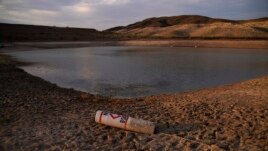03 October 2021
The U.S. government has predicted that an important river in the American West will have a water shortage.
The Bureau of Reclamation recently declared the first shortage on the Colorado River. The announcement means Arizona, Nevada and also Mexico will get less water than normal next year.

Drought Explainer Water Shortage
The Colorado River supplies Lake Powell and Lake Mead which is the largest man-made lake in the U.S. The lakes have been hard hit by drought in the past 30 years. The Colorado River supplies 40 million people with water.
Both lakes have decreased to historic lows. The lakes currently have a combined capacity of 39 percent, down from 49 percent at this time last year, the Bureau of Reclamation said.
The seven U.S. states that depend on the Colorado River agreed to a drought plan in 2019 to help support the lakes by reducing water use. All agree more needs to be done and are discussing what will replace a set of guidelines for the river and the drought plan. Both the guidelines and the drought plan end in 2026.
The water level on Lake Mead serves as a measure for how much river water some Western U.S. states get, including Arizona, Nevada and California.
By 2025, there is a 66 percent chance Lake Mead will reach a level where California would face cuts in water for a second time.
Lake Powell, on the Arizona-Utah border, is the guide for Colorado, New Mexico, Wyoming and Utah. Those states cover an area known as the upper basin.
Smaller lakes upstream of Lake Powell have been releasing water so Lake Powell can continue producing hydropower. But any increase from the releases is not included into the five-year estimates, the Bureau of Reclamation said.
Wayne Pullan is the bureau's director for the upper basin. In a statement, Pullan described the latest estimates for Lake Powell as "troubling."
The U.S. federal government has also formed a working group to consider the issue.
The Bureau of Reclamation's five-year estimates are meant to help water officials plan by using the best available information, said Jacklynn Gould.
Gould oversees the lower basin for the Bureau of Reclamation. Its August estimates are what decide how much water states can use.
The agency says there is a 22 percent chance that Lake Mead will drop to 304 meters above sea level in 2025. Federal officials have said water would become unavailable to states downstream at 272 meters above sea level.
I'm John Russell.
John Russell adapted this story from an Associated Press report. Mario Ritter, Jr. was the editor.
_____________________________________________________________
Words in This Story
drought – n. a long period of time during which there is very little or no rain
capacity – n. the ability to hold or contain people or things — usually singular
upstream – adv. in the direction opposite to the flow in a stream, river, etc. : toward the source of a stream, river, etc.
hydropower – n. electricity produced from machines that are run by moving water
unavailable – adj. not possible to get or use